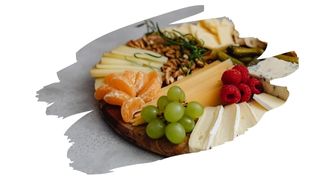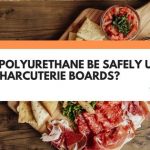One of the best ways to finish off and seal a charcuterie board is to simply saturate it with food grade mineral oil.
This non-toxic wood finish will soak right down into that board, protecting that timber surface from the inside out.
But what about a painted charcuterie board? Can mineral oil work just as well on painted wooden surfaces? Or will you need a more durable wood sealant instead?
Well, in this post, you’ll learn the difference between food safe and food grade — and what it means for food safety overall. You’ll also discover which food grade wood finish is the best sealer for a charcuterie board.
And keep reading to discover why painted charcuterie boards can be tricky to seal…

This post may contain affiliate links to products that we receive a commission for (at no additional cost to you). Learn more here.
Is There A Food Safe Sealer You Can Use For Painted Wood?
Arguably, any sealant that dries and cures into a solid hard film, is food safe. But, of course, this is provided it only contains FDA approved food-safe resins and ingredients.
Nevertheless, polyurethane is one such food-safe sealant.
This waterproofing wood finish will cure into a durable coat on the surface of your board. However, as a food safe finish, it isn’t actually suitable for surfaces that’ll have direct food contact.
So, if you planning on placing food directly onto that board, you shouldn’t apply a ‘food-safe’ sealant (or paint) onto it.
Wait A Second…I Used A Food Safe Paint! That Should Be Fine To Place Food On, Right?
Well, food safe does not equal safe for direct food contact.
So, food safe paints can be used to paint the walls of kitchens. They can even be safely used to coat surfaces in meat processing plants and water tanks.
But, food safe simply means that a finish is safe enough for indirect food contact (in a kitchen/dining setting).
You see, food safe finishes/stains/paints contain chemicals and ingredients that are not safe for human consumption. So, if they happen to get into your food, they can make you ill.
And here’s the thing; many food safe finishes/paints/stains can become damaged (or even break down) when they have direct food contact.
Related Post: Can You Apply Wood Stain To A Cutting Board?
For example, some types of paint can begin to dissolve if you get alcohol or vinegar onto them. And even durable food safe sealers like polyurethane can become damaged by the sharp blade of a cheese knife.
And all of this doesn’t even take into account that painting a charcuterie board makes it more difficult to maintain…
Why Shouldn’t You Paint A Charcuterie Board?
Well, the best way to seal a charcuterie board is to regularly saturate it with pure food grade mineral oil.
The mineral oil will soak down into wood, coating each fiber. And this non-drying oil will prevent those wood fibers from absorbing moisture.
This is why mineral oil is the gold standard for sealing food prepping surfaces, such as cutting boards and charcuterie boards.
But, a coat of paint will effectively seal over the surface of wood. So, once paint dries, it makes it next to impossible for mineral oil to sink down evenly into that charcuterie board.
Now, if your board is purely decorative, this isn’t an issue. You can go ahead and freely paint it.
But, if you plan on placing cheese, raw meat, and other food items atop it, then you need to keep it clean by washing it. And if you wash a wooden board, you need to oil it (with mineral oil) to prevent it from drying out or rotting.
This is why food prepping/serving wooden surfaces should only ever be coated with food grade finishes.
What’s The Difference Between Food Grade And Food Safe?
Food grade finishes are safe for direct contact with food.
These finishes are so ‘food-safe’ that they’re even fit for consumption. So, if they get into your food, they don’t pose a risk to your health.
But Why Would You Use Mineral Oil On A Charcuterie Board Anyway?
It’s because this non-drying food grade oil won’t go bad or become rancid — making it ideal as a wood finish.
However, it is not a very durable finish. Food grade mineral oil is heavily refined, but doesn’t dry and cure into a hard resin.
Still, it doesn’t wash off if you rinse it with water. And, most importantly, mineral oil is non-toxic.
In fact, it is so non-toxic that it is even safe for human consumption, so you needn’t worry if a bit of it gets into your food.
You can learn more about charcuterie board wood finishes by checking out our post here: What Type Of Wood Finish Is Best Used On A Charcuterie Board?
So How Do You Seal a Painted Charcuterie Board?
If that board is purely decorative, then any food safe sealant will do. Which means you can use Tung oil, Boiled Linseed oil, or even Polyurethane, to top coat it.
To Wrap Up, Here Are The 3 Key Takeaways From This Post…
- 1). Food safe wood finishes and paints are safe for indirect contact with food. However, they are not safe for direct contact with food.
- 2). Food grade wood finishes, such as pure food grade mineral oil, are safe enough to come into direct contact with food. These finishes work by soaking down into wood, preventing it from drying out and/or rotting away.
- 3). Mineral oil doesn’t work on painted charcuterie boards. The coat of paint will prevent mineral oil from soaking down into that wooden board.


